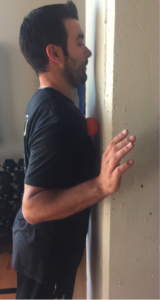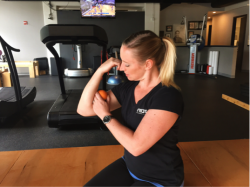Three ways your shoulder blade matters

The shoulder blade (anatomical name is scapula) is a flat bone lying on the upper back (thoracic wall) that is involved with all shoulder function. It synchronously moves during arm motion, acts as a stable base when shoulder muscles are activated, and is an important link in the kinetic chain for athletic and daily activities. There are 17 different muscles that attach to the scapula, and any alteration in one of those muscles can result in scapular dyskinesis which will impact mobility and function. An adaptation or shortening of a muscle may result in impingement pain or change scapular mobility preventing normal function of the muscles.
Here are three examples of how poor scapular positioning can contribute to shoulder blade pain or weakness.
I. EXCESSIVE SCAPULAR PROTRACTION
The inability to properly position the scapula can alter mechanics of overhead activities such as swinging a golf club or tennis racket, serving a volleyball, and swimming. Studies show scapular protraction is correlated with reduced force generating capabilities for internal and external rotators, decreasing shoulder stability and power. (Merolla)
How do I improve this?
- Muscles that produce scapular protraction and abduction such as serratus anterior, pectoralis major, and pectoralis minor must have appropriate length and flexibility to allow proper scapular retraction. Self soft tissue mobilization to the front of the shoulder helps achieve this flexibility.
- Pec Release

- Stand facing the wall. Then place the lacrosse ball 2 inches below the collarbone and toward your armpit
- Move the ball right and left until you find a tender area
- Next, move your arm and shoulder forward and back, then up and down
- Lean your body into the ball as tolerated
- Do these movements for 45 seconds or until the tension resolves
- Muscles released: pectoralis minor, pectoralis major
II. EXCESSIVE ANTERIOR TILT
Tightness in the pectoralis minor or short head of the biceps (which attach to the coracoid attachment of the scapula, tilting it forward) leads to abnormal motion. This will cause the scapula to move disproportionally anterior and inferior (aka forward and down) decreasing normal glenohumeral rotation, especially internal rotation mobility. This can affect throwing athletes because the poor position leads to compression forces and irregular articulations preventing full function and mobility. Continuing to move and throw with an excessive anterior tilt may lead to pain and injury. Pec minor and biceps tightness can also feed into excessive protraction of the scapula. (Kibler)
How do I improve this?
- Tight muscles that cause an anterior tilt such as the pectoralis minor and biceps must have appropriate length and flexibility to allow proper scapular positioning. Self soft tissue mobilization to the pec minor and biceps will help this
- Pec minor release shown above
- Biceps release with lacrosse ball
- Bicep Release

- Place a lacrosse ball above your elbow
- Flex and extend your elbow back and forth until you feel discomfort in that area decrease
- Move the ball along multiple sore spots up the arm
- Perform on both arms 3-5 minutes
III. ELEVATED SCAPULA
An elevated scapula can lead to impingement and cause irregular arm movement. More specifically, excessive activity of the upper trapezius combined with reduced activity of the low trap and serratus anterior can lead to impingement symptoms. This happens due to poor coordination of the forces that control the scapula. Stretching and improving control of the upper trapezius is important to decrease impingement pain and improve efficient shoulder mobility. (Huang)
How do I improve this?
- Muscles that cause a scapular elevation such as the upper trapezius or levator scapula must have appropriate length and flexibility to allow proper scapular positioning. Self soft tissue mobilization to the upper trapezius and levator scapula will help this
- Upper Trap and Levator Scap Release


- Stand with your shoulder under the bar or with a lacrosse ball placed half way between the neck and edge of the shoulder on the restricted side
- Move left and right until you find a tender area
- Upper trap: next shrug your shoulder up and down for 45 seconds or until the tension resolves
- Levator scap: look down and toward the armpit opposite the bar and back up. Repeat 45 seconds or until tension resolves